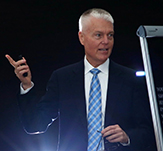How to Address the President
How to Address the President? Consider these two ways:
—–#1) Direct address. Actually writing or speaking to the President. See – How to address the current President.
—–#2) Referring to the President in conversation or in text. See – “How to Refer to the President?”
_____
The President of the United States (POTUS)
—-Envelope or address block on letter or email:
—-—-The President
—-—-The White House
—-—-1600 Pennsylvania Avenue, N.W.
—-—-Washington, DC 20500
—-Letter salutation:
—-—-Dear Mr./Madam President:
—-Conversation:
—-—-Mr./Madam President
Robert Hickey author of “Honor & Respect”
How to Address Joseph Biden
While the President is referred to in the media as President Biden, Joe Biden, and Biden, these are not correct forms of direct address. In direct address the President’s given and surname are not used.
—-Envelope, official:
—-—-The President
—-—-The White House
—-—-1600 Pennsylvania Avenue, N.W.
—-—-Washington, DC 20500
—-Letter salutation:
—-—-Dear Mr. President:
—-Complimentary close:
—-—-Most respectfully,
—-Announced:
—-—-The President of the United States
—-Introduction:
—-—-Mr. President, may I present …
—-Conversation:
—-—-Mr. President
— Robert Hickey

Robert Hickey author of “Honor & Respect”
How to Refer to The President?
How should the you refer to the current President (POTUS)? I hear Presidents refered to as Mr. (Surname) and this doesn’t sound respectful of him or the office.
———-– Ms. Brazile In Honolulu
Dear MBIH:
First we need to define:
(1) A reference to The President in a news story. This is not a form of address, it is an editorial issue.
(2) Direct forms of address used when addressing the President orally or in writing. Here are those forms.
—–You’ll hear and see these forms in the media:
———-(The Office) The President
—–—–(Full Name) Joseph R. Biden, Jr.
—–—–President (Name) President Biden
—–—–(Surname Only) Biden
—–—–Mr. (Surname) Mr. Biden
FIRST: Referring to the POTUS in orally or in writing as The President is always correct. There is only one President at any given time.
SECOND: In the media, reporters use all the forms above. When they do so, they are not addressing the President. The are referring to him and wanting to be clear of whom they are speaking. Some editorial style books state first references be — (Special honorific or rank)+(Name) | President Biden — and subsequent references be — Mr. (Name) | Mr. Biden. This editorial style is not disrespectful. It’s just a convention to streamline the text.
THIRD: In direct oral address – actually speaking to the President – the President is addressed as: Mr. President
—-His given name or surname are not used in his presence. This pattern of not using the name is typical around the world when addressing the highest officials – chiefs of state, heads of government, speakers of houses, chief justices and a very few others. Listen to a White House news conference: Reporters addressing the POTUS as Mr. President are doing it correctly.
FOURTH: You will hear people address the POTUS as President (Name) | President Biden. This is not traditionally correct. Maybe the speaker doesn’t know the tradition … or has been listening to the evening news and thinks their references to President (Full Name) | President Biden is how you’d address the POTUS?
Whenever I hear a reporter do it wrong, I think I should send them an informative note. After having done it innumerable times, I don’t think it does any good.
— Robert Hickey
See these Posts on The President:
———President of the United States
———President-elect of the United States
———Former President of the United States
———Spouse of the President of the United States
Robert Hickey author of “Honor & Respect”
When Should You Use the Forms on this Page?
You can use these forms of address for any mode of communication: addressing a letter, invitation, card or Email. (If there are differences between the official and social forms of address, I will have mentioned the different forms.) The form noted in the salutation is the same form you say when you say their name in conversation or when you greet them.
___What I don’t cover on this site are many things I do cover in my book: all the rules of forms of address, about names, international titles, precedence, complimentary closes, details on invitations, place cards, all sorts of introductions, etc. I hope you’ll get a copy of the book if you’d like the further detail.
Not Finding Your Answer?
—-#1) At right on desktops, at the bottom of every page on tablets and phones, is a list of all the offices, officials & topics covered on the site.
—-#2) If you don’t see the official you seek included or your question answered send me an e-mail. I am pretty fast at sending a reply: usually the next day or so (unless I am traveling.) Note: I don’t have mailing or Email addresses for any of the officials and I don’t keep track of offices that exist only in history books.
—-#3) If I think your question is of interest to others, Sometimes I post the question – but always change all the specifics.
— Robert Hickey
Robert Hickey author of “Honor & Respect”
Recommended Resources: The Protocol School of Washington (PSOW) and Protocol and Diplomacy International – Protocol Officers Association (PDI-POA) For more information see the Protocol Resources page.


